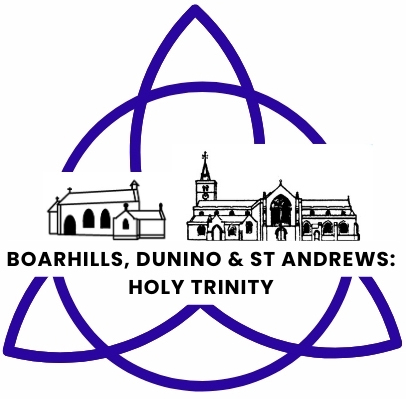Stained-glass windows are an important integral feature of any church building. Their tracery and glazing form part of the architecture but are also a teaching aid – as much for us today as they were in the Middle Ages. The stories depicted and the symbolism used helps to teach about Faith and preach the Gospel. But they are also incredibly beautiful and have a magical quality of light. At various times of the day, rainbows can be seen throughout Holy Trinity as the light beams through the stained-glass.



All the stained-glass windows in Holy Trinity are memorial windows given by generous donors and dedicated in the first instance to the glory of God. Of all the stained-glass windows in Holy Trinity, only 3 out of 11 were in position at the time of the rededication of the church in 1909. The artist commissioned to make the stained-glass windows at the time of the rebuild were at the top of their profession.
The positioning of stained-glass windows within a church usually run to a pattern. Traditionally, windows have been positioned together with New Testament stories and their related Old Testament stories side-by-side or opposite each other. (OT on the north side and NT on the south side). In Holy Trinity, the stained-glass windows are carefully grouped.
The Great East Window illustrates the Te Deum Laudamus (We Praise Thee O God) canticle, and the north transept window depicts the Benedicite Omnia Opera (O all ye works of the Lord bless ye the Lord) canticle. The north aisle windows depict Old Testament Heroes, while the windows in the Hunter Memorial Aisle and the south aisle illustrate the life and works of Christ. The main south transept window represents Resurrection and Ascension, while the great west window remembers the work of women for Christ and His Church.
Scotland has a long and rich heritage of stained glass. Commercial studios throughout the country have nurtured many talented designers, including Robert Douglas Strachan (known as Douglas Strachan), Louis Davis, Reginald Hallward and James Powell & Sons. Holy Trinity is literally a treasure house of 20th Century stained-glass art.



The image below shows the positioning of the stained-glass windows within Holy Trinity which can be used when touring the church.
Stained-glass windows of Holy Trinity:
- The Boy Christ – Douglas Strachan, 1912
- The Early Leaders of Israel – Douglas Strahan, 1920
- Three Old Testament Kings – Douglas Strachan, 1923
- The Perfect Woman – Douglas Strachan, 1918
- The Perfect Knight – Douglas Strachan, 1920
- Benedicite Omnia Opera – James Powell & Sons, 1912
- Christ Heals the Blind Man – Herbert Hendrie, 1930
- Abraham & Melchisidec – Douglas Strachan, 1923
- The Minor Prophets – Douglas Strachan, 1922
- The Good Physician – A Ballantine & Son, 1890
- The Great East Window – Douglas Strachan
- The Miracles – Douglas Strachan, 1910
- The Whole Armour of God – William Wilson, 1950
- The Crucifixion
- The Agony of Gethsemane
- The Baptism of Christ
- The Nativity
- Justice – Douglas Strachan, 1926
- The Resurrection and Ascension – Reginald Hallward, 1912
- St Thomas – Sax Shaw, 1968
- St Margaret – Sax Shaw, 1968
- Jesus Christ – Herbert Hendrie, 1928
- St Paul & Daniel – Alexander Strachan, 1921
- Christ’s Mission to the World – James Powell & Sons, 1912
- Christ’s Mission to Children – James Powell & Sons, 1912
- The Great West Window – Douglas Strachan, 1914
The Clerestory contains 17 World War I Memorial windows, each depicting a badge of a regiment. The 12 Scottish Regimental badges are accompanied by a thistle, but the others include a rose and shamrock. The artist of these windows was Alexander Strachan.
We have a booklet available for sale in the church with more information about the stained-glass windows of Holy Trinity and we hope you will come and enjoy a tour of our beautiful building with its stunning stained-glass windows.






More information can also be found on the Visit Stained Glass website.


